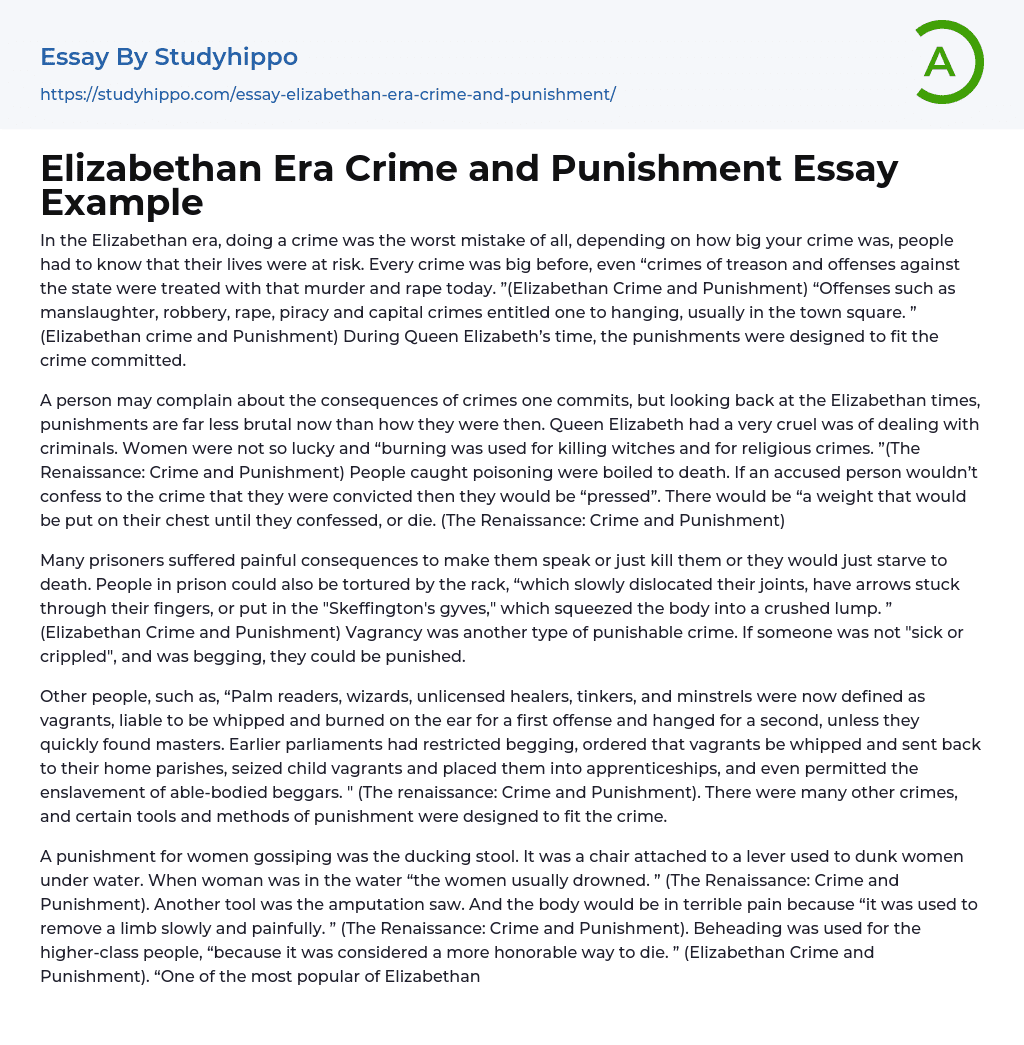In the Elizabethan era, doing a crime was the worst mistake of all, depending on how big your crime was, people had to know that their lives were at risk. Every crime was big before, even “crimes of treason and offenses against the state were treated with that murder and rape today. ”(Elizabethan Crime and Punishment) “Offenses such as manslaughter, robbery, rape, piracy and capital crimes entitled one to hanging, usually in the town square. ” (Elizabethan crime and Punishment) During Queen Elizabeth’s time, the punishments were designed to fit the crime committed.
A person may complain about the consequences of crimes one commits, but looking back at the Elizabethan times, punishments are far less brutal now than how they were then. Queen Elizabeth had a very cruel was of dealing with criminals. Women
...were not so lucky and “burning was used for killing witches and for religious crimes. ”(The Renaissance: Crime and Punishment) People caught poisoning were boiled to death. If an accused person wouldn’t confess to the crime that they were convicted then they would be “pressed”. There would be “a weight that would be put on their chest until they confessed, or die. (The Renaissance: Crime and Punishment)
Many prisoners suffered painful consequences to make them speak or just kill them or they would just starve to death. People in prison could also be tortured by the rack, “which slowly dislocated their joints, have arrows stuck through their fingers, or put in the "Skeffington's gyves," which squeezed the body into a crushed lump. ” (Elizabethan Crime and Punishment) Vagrancy was another type of punishable crime. If someone wa
not "sick or crippled", and was begging, they could be punished.
Other people, such as, “Palm readers, wizards, unlicensed healers, tinkers, and minstrels were now defined as vagrants, liable to be whipped and burned on the ear for a first offense and hanged for a second, unless they quickly found masters. Earlier parliaments had restricted begging, ordered that vagrants be whipped and sent back to their home parishes, seized child vagrants and placed them into apprenticeships, and even permitted the enslavement of able-bodied beggars. " (The renaissance: Crime and Punishment). There were many other crimes, and certain tools and methods of punishment were designed to fit the crime.
A punishment for women gossiping was the ducking stool. It was a chair attached to a lever used to dunk women under water. When woman was in the water “the women usually drowned. ” (The Renaissance: Crime and Punishment). Another tool was the amputation saw. And the body would be in terrible pain because “it was used to remove a limb slowly and painfully. ” (The Renaissance: Crime and Punishment). Beheading was used for the higher-class people, “because it was considered a more honorable way to die. ” (Elizabethan Crime and Punishment). “One of the most popular of Elizabethan punishments was the pillory. ” (Elizabethan Crime and Punishment).
The pillory had a wooden block with three holes in it for the head and hands. Criminals would be locked up in the pillory and wait in public for their decided punishment. There were different variations of the pillory. The stocks were like the pillory except that the feet were locked up. They were “used for
public drunkenness and for temporarily holding a criminal. ”(The Renaissance: Crime and Punishment) In another type of pillory, “toes were put through holes and smashed by a hammer and wedge. ” (Elizabethan Crime and Punishment). The finger pillory was used for higher classed people for bad behavior during social gatherings.
It was very painful for finger because they would be put into a “block of wood and kept bent at a ninety-degree angle at the middle knuckle. ” (Elizabethan Crime and Punishment). There were many laws and “everyone was confined within strictly defined limits, which were imposed and enforced by the ruling estates, the clergy and the feudal nobility. ” (Martin) Elizabethan crime and punishments are very different from those of today. Judicial systems, prisons, and the Constitution prevent these cruel and unusual punishments from happening. Treason is no longer a reason for death, and strange torture devices are not used for punishing a criminal.
- Mass Incarceration essays
- 1984 essays
- A Farewell to Arms essays
- A Good Man Is Hard to Find essays
- A Hanging essays
- A Lesson Before Dying essays
- A Long Way Gone essays
- A Rose For Emily essays
- A Separate Peace essays
- A Tale Of Two Cities essays
- A Very Old Man With Enormous Wings essays
- Adventures Of Huckleberry Finn essays
- Alice in Wonderland essays
- All Quiet on The Western Front essays
- Allegory of the Cave essays
- An occurrence at owl creek bridge essays
- Animal Farm essays
- Anthem essays
- Antigone essays
- Arthur Conan Doyle essays
- As I Lay Dying essays
- Atticus Finch essays
- Barn Burning essays
- Battle Royal essays
- Beauty and The Beast essays
- Beloved essays
- Boo Radley essays
- Brave New World essays
- Candide essays
- Castle essays
- Characters In Hamlet essays
- Characters In Romeo And Juliet essays
- Christmas carol essays
- Chronicle of a Death Foretold essays
- Cinderella essays
- Crime and Punishment essays
- Daisy Miller essays
- Death of a Salesman American Dream essays
- Desdemona essays
- Diary Of A Wimpy Kid essays
- Dracula essays
- Dubliners essays
- Emma essays
- Ender'S Game essays
- Ethan Frome essays
- Eveline essays
- Fahrenheit 451 essays
- First-Person Narrative essays
- Fish Cheeks essays
- Frankenstein essays




